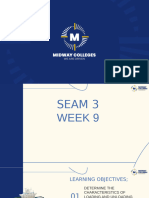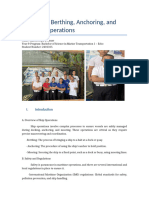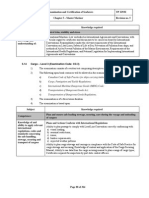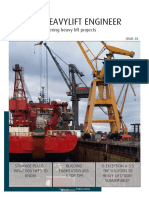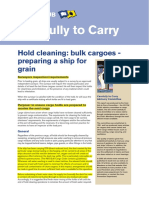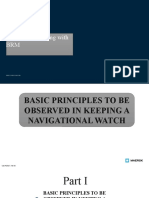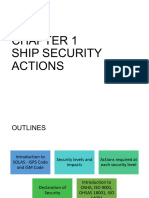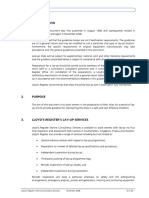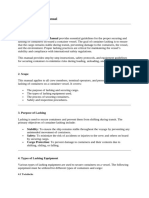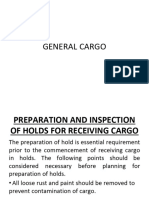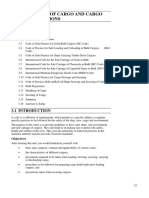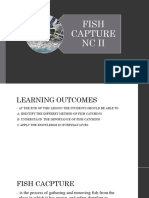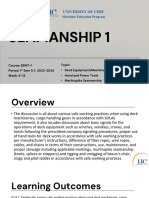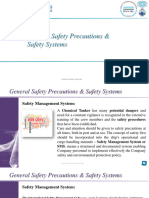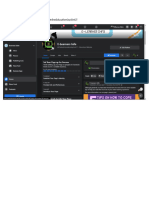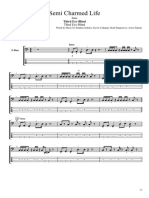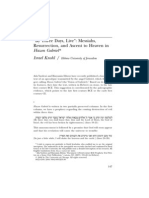Summary SEAM
Summary SEAM
Uploaded by
madbullet141Copyright:
Available Formats
Summary SEAM
Summary SEAM
Uploaded by
madbullet141Copyright
Available Formats
Share this document
Did you find this document useful?
Is this content inappropriate?
Copyright:
Available Formats
Summary SEAM
Summary SEAM
Uploaded by
madbullet141Copyright:
Available Formats
Summary Seam
Summary 7 • Comply with MARPOL regulations
regarding wash water and cargo
Importance of Hold Cleaning residues.
Proper cleaning of a vessel’s cargo holds Safety and Compliance
is crucial for preventing cargo
contamination and avoiding claims • Conduct risk assessments and provide
related to delays or damages. training on safe chemical handling.
Adherence to cleanliness standards set • Maintain accurate records of cleaning
by the International Maritime Solid Bulk operations for compliance and dispute
Cargoes (IMSBC) Code is essential. resolution.
• Regular inspections should be part of a
Cleanliness Standards
planned maintenance system to identify
Hospital Clean: Required for high-grade and address defects.
cargoes; all residues must be removed,
Communication and Documentation
and surfaces washed, dried, and
ventilated. • Clear voyage instructions should outline
cleaning standards and responsibilities.
Grain Clean: Default standard for most
bulk cargoes; involves thorough • Maintain open communication with
removal of past residues, washing with charterers regarding cleaning
seawater and fresh water, and procedures and compliance.
ensuring ventilation.
Barrier Coatings
Normal Clean: For similar cargoes;
• For corrosive cargoes, applying barrier
includes double sweeping, saltwater
coatings can protect hold structures and
washing, and freshwater rinsing.
facilitate easier cleaning.
Swept Clean/Shovel Clean: Basic
Post-Cleaning Inspections
cleaning methods where residues are
removed by sweeping or shoveling. • Conduct thorough inspections in well-lit
conditions and document findings to
Load on Top: Minimal cleaning;
ensure compliance and avoid disputes.
however, periodic cleaning is advisable
to allow inspections.
Cleaning Process
• Conduct thorough pre-cleaning
inspections.
• Use appropriate chemicals and follow
safety protocols.
• Ensure proper drying and ventilation of
holds before loading.
Summary Seam
Summary 8 General Cargo
Solid Bulk Cargo Break-Bulk Cargo: Not packaged but
requires safe stowage and securing,
Handling: Ensure holds are clean guided by the CSS Code.
and free from residue; use Advice: Use dunnage for load
equipment like conveyors or cranes distribution; secure cargo with
to minimize dust and spillage. lashings or supports as needed.
Types: Dry bulk (e.g., grains, coal) vs. Stowage Arrangements:
liquid bulk (e.g., oil, chemicals), each o Cross stowage: Cargo
with specific requirements. arranged athwartships.
Planning & Safety: Comprehensive o Side stowage: Cargo against
stowage plans are crucial to prevent the ship's side.
overloading; adhere to international o Single stowage: Individually
regulations (IMSBC Code). secured heavy items.
Key Procedures:
o Declare cargo characteristics Container Cargo
before loading.
o Collect essential information Stowage Planning: Essential for
from shore terminals. vessel stability; heavier containers
o Prepare for cargo operations go below, lighter on top.
considering stability and Technology: Advanced software and
structural integrity. automation improve efficiency and
o Monitor loading to prevent safety.
shifting and ensure Regulations: Follow IMO standards
watertight security. and IMDG Code for hazardous
o Handle hazardous cargo materials.
following IMSBC guidelines.
o Trim cargo and perform final Ro-Ro (Roll-On/Roll-Off) Cargo
checks to ensure safety.
Handling: Efficient loading via
Liquid Bulk Cargo ramps; vehicles secured using
chocks and lashing.
Definition: Includes crude oil, Safety: Adherence to SOLAS
chemicals, and food-grade liquids, regulations to ensure security and
requiring specialized storage. reduce accidents.
Handling: Use pumps and transfer Advantages: Faster operations,
systems to prevent spills; storage in reduced risk of damage, versatile
tanks with safety features. cargo handling.
Equipment: Flexitanks and ISO tanks
offer flexible and standardized
storage solutions.
Summary Seam
Heavy Lift Cargo • All cargoes should be stowed and
secured in such a way that the ship and
Importance: Proper stowage to persons on board are not put at risk.
ensure safety; items positioned to • The safe stowage and securing of
avoid dragging. cargoes depend on proper planning,
Preparations: Assess weight, size, execution, and supervision.
support points, and lifting
attachments. • Personnel commissioned to tasks of
Safety: Maintain vessel stability, cargo stowage and securing should be
restrict shore personnel, and use properly qualified and experienced.
appropriate supports.
• Decisions taken for measures of
stowage and securing cargo should be
SUMMARY WEEK 9
based on the most severe weather
1. Importance of Proper Cargo Stowage and conditions which may be expected by
Securing experience for the intended voyage.
Proper stowage and securing of cargo is of • Ship-handling decisions taken by the
utmost importance for the safety of life at sea. master should take into account the
Improper stowage and securing of cargoes has type and stowage position of the cargo
resulted in numerous serious ship casualties and the securing arrangements.
and caused injury and loss of life, not only at
4. Cargo Securing Methods
sea but also during loading and discharge.
Cargo can be secured through a combination of
2. Applicable Standards and Guidelines
the following methods:
The International Maritime Organization (IMO)
• Blocking and bracing
has developed several codes and guidelines to
deal with the problems and hazards arising from • Tiedowns, with a specific number of tie-
improper stowage and securing of cargo, downs required based on the cargo's
including: size and weight
Code of Safe Practice for Cargo Stowage and • Friction mats, void fillers, and other
Securing (CSS Code) cargo to immobilize the cargo
Code of Practice for Packing of Cargo Transport • The specific securement system used
Units (CTU Code) should depend on the cargo's
characteristics and the expected
These codes and guidelines provide
weather conditions during the voyage.
international standards and advice to promote
the safe stowage and securing of cargoes. • Proper planning, execution, supervision,
and regular inspection of the cargo
3. General Principles for Cargo Stowage and
securement system are crucial to
Securing
ensure the safety of the ship, its crew,
According to the CSS Code, the following and the cargo during the voyage.
general principles should be observed:
Summary Seam
Summary 10 Special Cargo Requirements
Objective: Prevent cargo damage during • Hygroscopic Cargoes: Monitor moisture
transport and ensure it arrives in good and ventilation to prevent damage.
condition. • Hazardous Cargoes: Follow specific
Understanding Cargo: Know the cargo's guidelines for ventilation and safety
characteristics, risks, and handling methods. procedures.
The Master is responsible for safe loading and Regular Monitoring
stowage.
• Check cargo conditions
Temperature and Humidity Control: frequently.Ensure refrigerated
• Monitor temperature and humidity containers are functioning properly.
using data loggers. Avoiding Wet Damage
• Use refrigerated containers (reefers) for • Inspect for leaks and water
sensitive cargo. accumulation, particularly during
• Ventilation is crucial to prevent 'ship adverse weather.
sweat' (condensation on ship Documentation
structures) and 'cargo sweat'
(condensation on cargo). • Maintain detailed records of inspections
and actions taken for accountability and
Ventilation future reference.
• Natural Ventilation: Allows air
exchange through deck vents; essential
for cargoes emitting toxic gases.
• Mechanical Ventilation: Uses fans for
air movement; required for flammable
gases and certain cargoes like
ferrosilicon. Ensure exhaust ventilation
for self-heating cargoes.
• Ventilation Rules: Follow dew point and
three-degree rules for determining
when to ventilate.
Recordkeeping
• Log outside and hold temperatures,
dew points, sea temperature, weather
conditions, and ventilation times.
• Document any interruptions in
ventilation and cargo condition checks.
Summary Seam
Summary 11
Effective Ship-Shore Communications for Cargo Hazard Communication
Operations • Risks: Discuss potential hazards such as
1. Pre-Arrival Information: spills, health risks, and environmental
damage.
1. Ship Details: ETA, name, IMO
number, dimensions, cargo Operational Procedures
handling gear, etc. • Sequence: Agreed loading/unloading
2. Operational Plan: Cargo procedures and equipment used.
quantity, loading/unloading • Weight Updates: Frequent updates on
plan, time for de-ballasting. cargo weight for stability monitoring.
3. Cargo Operations Planning: Damage Reporting
4. Communication: Establish • Protocol: Clear procedure for reporting
methods and procedures to halt any damage to the vessel.
operations if needed.
5. Personnel: Designate
responsible individuals on both
ship and shore.
6. Cargo Weight: Regular updates
and end-of-pour weights.
7. Draught Checking & Damage
Reporting: Procedures for both.
3. Safety And Readiness:
• Readiness Check: Confirm no structural
damage,
• working bilge/ballast systems.
• Protocols: PPE usage, safe equipment
handling, and
• confined space entry.
4. Emergency Procedures:
• Checklist: Ship-shore safety checklist
and emergency stop signals.
• Equipment: Availability of spill cleanup
and firefighting gear.
Summary Seam
It can hinder inspections due to
residues obstructing the view.
QUIZ 7
1. Understanding the specific
requirements for cargo hold
cleanliness involves recognizing
which of the following? 8. When conducting the
The type of cargo being loaded. cleaning process, what is the
recommended sequence for
2. What is the primary reason washing the cargo hold?
for adhering to the 'hospital clean'
standard in cargo hold cleaning?. Wash from top to botto
To prevent cargo contamination 9. How should surfaces be
prepared before applying
3. Why is it important to cleaning chemicals?
distinguish between 'grain
clean' and 'normal clean' Ensuring they are free of loose
standards? rust, bare steel, or unpainted areas
To ensure appropriate cleaning
levels for different types of 10. What is the minimum
cargoes. distance from the nearest land
or ice shelf where cargo
4. Which standard of cleaning residues can be discharged
is typically used when there according to MARPOL Annex V?
are no specific instructions
provided for the cargo? 12 nautical miles
Normal clean
5. Analyzing the impact of QUIZ 8
not properly cleaning cargo 1. Why is it important to
holds before loading a new monitor conditions like
cargo, what could be a humidity and temperature
potential consequence? during the transport of
Cargo contamination leading to bulk cargo?
claims and disputes. To ensure the quality of perishable
goods
6. When cleaning holds to the 2. What is the role of the shipper in the
'swept clean' standard, what is declaration of cargo characteristic?
typically required? To provide detailed information
about the cargo's properties
A basic sweep and removal of 3. During loading operations, what is
residues. the main concern regarding cargo
distribution?
7. How does the 'load on top' Preventing cargo from shifting and
standard impact the inspection ensuring vessel stability
of cargo hold structures?
Summary Seam
4. What is a critical requirement for
handling hazardous bulk cargo?
You might also like
- Emaar SPADocument21 pagesEmaar SPABritton Whitaker100% (1)
- Cargo Handling and Stowage: A Guide for Loading, Handling, Stowage, Securing, and Transportation of Different Types of Cargoes, Except Liquid Cargoes and GasFrom EverandCargo Handling and Stowage: A Guide for Loading, Handling, Stowage, Securing, and Transportation of Different Types of Cargoes, Except Liquid Cargoes and GasRating: 5 out of 5 stars5/5 (11)
- Oxford - English Plus 3 WordlistDocument33 pagesOxford - English Plus 3 WordlistThanh TuanNo ratings yet
- Fce Language Practice With Key Macmillan PDFDocument2 pagesFce Language Practice With Key Macmillan PDFNate100% (2)
- 3.0 Cargo CareDocument12 pages3.0 Cargo CareNelum Perera100% (1)
- Seam 4 Cargo Handling and Stowage Dangerous GoodsDocument47 pagesSeam 4 Cargo Handling and Stowage Dangerous GoodsVince Trinanes100% (2)
- WEEK 9 PPTs Characteristic Loading and Unloading RequirementsDocument22 pagesWEEK 9 PPTs Characteristic Loading and Unloading Requirementshecidi 7889No ratings yet
- Simplified Cargo Manual for ContainersDocument5 pagesSimplified Cargo Manual for ContainersAlexander MiroshnichenkoNo ratings yet
- Project Cargo Checklist Proof 8Document8 pagesProject Cargo Checklist Proof 8sugiyantoNo ratings yet
- Cargo 22 SolutionDocument9 pagesCargo 22 Solution8727ashishkumarNo ratings yet
- Safety Tips for Non-Dangerous Cargo Handling.docx_20241015_083555_0000Document21 pagesSafety Tips for Non-Dangerous Cargo Handling.docx_20241015_083555_0000Jan Chris PantiNo ratings yet
- Cargo SafetyDocument6 pagesCargo SafetyGaurav MaithilNo ratings yet
- Standard Bulk Cargoes-Hold Preparation and CleaningDocument32 pagesStandard Bulk Cargoes-Hold Preparation and CleaningSoyHan BeLen100% (3)
- Chapter_5_Berthing_Anchoring_Mooring_Operation_ModuleDocument4 pagesChapter_5_Berthing_Anchoring_Mooring_Operation_ModuleMark AznarNo ratings yet
- Ambar TemizlemeDocument16 pagesAmbar TemizlemeemineNo ratings yet
- FINAL SQA Cargo Questions PDFDocument41 pagesFINAL SQA Cargo Questions PDFCherian KuttyNo ratings yet
- 1.BULK CARGOES Hold PreparationDocument11 pages1.BULK CARGOES Hold Preparationarshit sharma100% (1)
- Aviva Road Tanker Loading and Unloading LpsDocument10 pagesAviva Road Tanker Loading and Unloading LpsFaker DAOUDNo ratings yet
- Ism, Min's, MGN, S MSN, SDocument11 pagesIsm, Min's, MGN, S MSN, SJhon FernandesNo ratings yet
- Bridge Organisation-2Document16 pagesBridge Organisation-2Petar Saydenov100% (4)
- Seatwork Seamanship: Cesar, Matthew BSMT21-B5Document6 pagesSeatwork Seamanship: Cesar, Matthew BSMT21-B5Matthew LimNo ratings yet
- Course: MTEC 102 Period: PRELIM Week: 2 Session: 1 Topic: Procedures For Safe Mooring-Deployment and Monitoring of Moorings For Cargo ShipDocument14 pagesCourse: MTEC 102 Period: PRELIM Week: 2 Session: 1 Topic: Procedures For Safe Mooring-Deployment and Monitoring of Moorings For Cargo ShipMeljorin LayeseNo ratings yet
- Carriage of Break Bulk and Project Cargoes GuidanceDocument4 pagesCarriage of Break Bulk and Project Cargoes Guidancefirman yantoNo ratings yet
- TP2293E - CG3 SyllabusDocument10 pagesTP2293E - CG3 Syllabusmrraj69100% (1)
- Bulk Cargoes Hold Preperation & Cleaning PDFDocument32 pagesBulk Cargoes Hold Preperation & Cleaning PDFSamir Alshaar100% (1)
- The Heavylift Engineer: ... Managing & Delivering Heavy Lift ProjectsDocument28 pagesThe Heavylift Engineer: ... Managing & Delivering Heavy Lift ProjectsneelcorNo ratings yet
- Carefully To Carry: Hold Cleaning: Bulk Cargoes - Preparing A Ship For GrainDocument13 pagesCarefully To Carry: Hold Cleaning: Bulk Cargoes - Preparing A Ship For Grainbigenur100% (2)
- Deck Watchkeeping - Basic PrinciplesDocument50 pagesDeck Watchkeeping - Basic Principlesneo miala100% (3)
- Cargo - Stowage - and - Securing. - MUNTEAN VICTOR PDFDocument23 pagesCargo - Stowage - and - Securing. - MUNTEAN VICTOR PDFKoldo Gómez AlzibarNo ratings yet
- Cargo Securing ManualDocument38 pagesCargo Securing ManualKannanNo ratings yet
- Informative Guide About Bulk and Grain CargoesDocument16 pagesInformative Guide About Bulk and Grain CargoesKen Portugalete100% (2)
- Deckwatch Keeping in PortDocument11 pagesDeckwatch Keeping in PortAldrich BunyiNo ratings yet
- Seamanship ReviewerDocument6 pagesSeamanship ReviewerslalarraNo ratings yet
- HSOB2010 - Element 1 - Presentation 2Document76 pagesHSOB2010 - Element 1 - Presentation 221amrikamaharajNo ratings yet
- Safe ManningDocument2 pagesSafe Manningzeropenn00No ratings yet
- Carriage of GrainDocument11 pagesCarriage of GrainAndrija BoskovicNo ratings yet
- AMastersGuidetoContainerSecuring2ndEdition 3Document50 pagesAMastersGuidetoContainerSecuring2ndEdition 3tenedero100% (1)
- PSSM RevisionDocument34 pagesPSSM RevisionAnselm Ted MajanilNo ratings yet
- Bulk Carrier SafetyDocument119 pagesBulk Carrier Safetyahmet yasin karlık100% (1)
- LRLayupGuideNov091.pdf 6 10Document5 pagesLRLayupGuideNov091.pdf 6 10Cip GrecuNo ratings yet
- Assignment of Module 9: Ensuring A Safe and Secure PortDocument7 pagesAssignment of Module 9: Ensuring A Safe and Secure PortJustonlyouNo ratings yet
- Container Lashing ManualDocument5 pagesContainer Lashing ManualAlexander MiroshnichenkoNo ratings yet
- 12.1.4 Care of Cargoes During CarriageDocument89 pages12.1.4 Care of Cargoes During Carriageshashwat.rohilla2907No ratings yet
- Cargo Jan 2011 Bulletinv 06Document32 pagesCargo Jan 2011 Bulletinv 06vamsiarangiNo ratings yet
- Lo2 4Document12 pagesLo2 4Karl NagacNo ratings yet
- Chemical TankersDocument22 pagesChemical Tankers16 - AniruthNo ratings yet
- Cargo Securing Manual for Container VesselDocument5 pagesCargo Securing Manual for Container VesselAlexander MiroshnichenkoNo ratings yet
- Week 5 Cargo Handling and SafetyDocument45 pagesWeek 5 Cargo Handling and SafetyKhal VentureNo ratings yet
- 2m Orals 3Document191 pages2m Orals 3Ravi Singh100% (1)
- Preparing Cargo Holds - Loading Solid Bulk CargoesDocument14 pagesPreparing Cargo Holds - Loading Solid Bulk Cargoesvdeviv100% (5)
- Loading of Cargo and Cargo RegulationsDocument23 pagesLoading of Cargo and Cargo RegulationsVibhav KumarNo ratings yet
- Marine Operations RevisionDocument36 pagesMarine Operations RevisionCacc BacNo ratings yet
- Seam4 PPT Week 13Document25 pagesSeam4 PPT Week 13Jayson JuradoNo ratings yet
- Seam 3 - Mod 5Document47 pagesSeam 3 - Mod 5Jonalyn CordovaNo ratings yet
- Group1 Dwatch2 Report (Final)Document29 pagesGroup1 Dwatch2 Report (Final)irby AcabadoNo ratings yet
- Fish-Capture - ALL TOPICDocument100 pagesFish-Capture - ALL TOPICAnya EleginoNo ratings yet
- SEAM 1 WK 9 12Document104 pagesSEAM 1 WK 9 12Jayren Abdul BakarrNo ratings yet
- General Safety Precautions, Safety SystemsDocument14 pagesGeneral Safety Precautions, Safety Systemsandrej.sukoraNo ratings yet
- Safety Guide - ENG - FinalDocument52 pagesSafety Guide - ENG - FinalSuresh DevarakondaNo ratings yet
- International Regulations for Preventing Collisions at SeaFrom EverandInternational Regulations for Preventing Collisions at SeaNo ratings yet
- Confident Powerboating: Mastering Skills and Avoiding Troubles AfloatFrom EverandConfident Powerboating: Mastering Skills and Avoiding Troubles AfloatNo ratings yet
- navn REVIEWER DR,EP,RUNNING FIXDocument35 pagesnavn REVIEWER DR,EP,RUNNING FIXmadbullet141No ratings yet
- WEEK 13 WATERTIGHT INTEGRITYDocument15 pagesWEEK 13 WATERTIGHT INTEGRITYmadbullet141No ratings yet
- navi reviewerDocument11 pagesnavi reviewermadbullet141No ratings yet
- WEEK 13 SEA AND SWELL WAVES AND THE OCEAN CURRENTSDocument17 pagesWEEK 13 SEA AND SWELL WAVES AND THE OCEAN CURRENTSmadbullet141No ratings yet
- ICT PAGEDocument1 pageICT PAGEmadbullet141No ratings yet
- #20 Online JobsDocument24 pages#20 Online Jobsrani velia vsNo ratings yet
- (Xavier Institute of Development Action and Studies) : Post Graduate Diploma in ManagementDocument16 pages(Xavier Institute of Development Action and Studies) : Post Graduate Diploma in Managementpriyankverma1No ratings yet
- Coursefm 1105Document26 pagesCoursefm 1105api-3723125100% (1)
- Mr Sandeep Modular FinalDocument51 pagesMr Sandeep Modular FinalvarunsardanaNo ratings yet
- Laws of SexDocument4 pagesLaws of SexveroegNo ratings yet
- Paternity Test by Multiplex PCR On STR Polymorphic Markers: (Practical Activity in The Cybertory Virtual Laboratory)Document3 pagesPaternity Test by Multiplex PCR On STR Polymorphic Markers: (Practical Activity in The Cybertory Virtual Laboratory)Albita LameiroNo ratings yet
- Tectonic Evolution and PaleogeographyDocument24 pagesTectonic Evolution and PaleogeographyIlber Noa AmancaNo ratings yet
- Certificate: "Accounts & Finance" by "N Sowmya" Is Her Original WorkDocument8 pagesCertificate: "Accounts & Finance" by "N Sowmya" Is Her Original WorkMohammed MohammedNo ratings yet
- Learning of Foreign Language in Pre-School Children: Evaluation Methods in Kindergarten'S EnvironmentDocument18 pagesLearning of Foreign Language in Pre-School Children: Evaluation Methods in Kindergarten'S EnvironmentGK Ria 1624No ratings yet
- Third Eye BlindsemiSemi Charmed Life-Bass2Document6 pagesThird Eye BlindsemiSemi Charmed Life-Bass2FADBASSNo ratings yet
- Telephone Doctor Series - 021213Document1 pageTelephone Doctor Series - 021213Amit HazareNo ratings yet
- Research Paper in English: Northern Mindanao Colleges IncDocument18 pagesResearch Paper in English: Northern Mindanao Colleges IncPenny Ü PiñonNo ratings yet
- Shortcut KeysDocument2 pagesShortcut KeysGudapati SurendranadhchowdharyNo ratings yet
- Audit (2nd Copy)Document10 pagesAudit (2nd Copy)Syed AliNo ratings yet
- PortfolioDocument29 pagesPortfolioViraj Solanki100% (1)
- MAY Parasols, English Catalogue For Commercial ParasolsDocument110 pagesMAY Parasols, English Catalogue For Commercial ParasolsKlaus MayNo ratings yet
- Tutorial 3: Stock Index Futures ContractsDocument10 pagesTutorial 3: Stock Index Futures ContractsDR LuotanNo ratings yet
- Acute Coronary Syndrome Case FileDocument4 pagesAcute Coronary Syndrome Case Filehttps://medical-phd.blogspot.comNo ratings yet
- PAL Vs MIANODocument1 pagePAL Vs MIANOShaira Mae CuevillasNo ratings yet
- Akips Installation GuideDocument14 pagesAkips Installation GuideHanan AbbasNo ratings yet
- HACCP Study JoghurtDocument13 pagesHACCP Study JoghurtAliNo ratings yet
- Gawad Sa Mga Manlilikha NG BayanDocument65 pagesGawad Sa Mga Manlilikha NG BayansamNo ratings yet
- Israel Knohl On Hazon GabrielDocument12 pagesIsrael Knohl On Hazon GabrielShalom Hartman Institute100% (1)
- 2W Multi Brand Repair StudioDocument26 pages2W Multi Brand Repair StudioShubham BishtNo ratings yet
- Planning A Successful Upgrade To Siebel 8.x: Robert Ponder and Subodh Patra Ponder Pro ServeDocument31 pagesPlanning A Successful Upgrade To Siebel 8.x: Robert Ponder and Subodh Patra Ponder Pro ServeRiah Jasmin Lao TanNo ratings yet
- The Politics of Religious Conversion Lindley-HighfieldDocument169 pagesThe Politics of Religious Conversion Lindley-Highfieldnuricerkes85No ratings yet
- Fbp1 SB Module 6Document14 pagesFbp1 SB Module 6Márta Flóra TarNo ratings yet







